It has been a little while since I’ve written a blog post, but the other day I was doing some invertebrate surveying in the new bug garden and I just had to write about all the wildlife which we see at the park. We are of course a wildlife park, and we mostly specialise in exotic species. If you come to the park you can see all sorts of species including tigers, moon bears, orangutans, giraffes, chimps, penguins, tarantulas and much, much more!
In terms of British species the numbers are much lower with our European wild cats and of course now also white clawed crayfish. So what I wanted to tell you about has nothing to do with our animals… It’s all about the wildlife which comes and visits our park!

After all, if you’re here to enjoy learning about our amazing animals, what better environment than one where you’re also surrounded by butterflies, bumble bees and wild birds?

We know that we do everything we can to try and make the park attractive to wildlife as well as having you all come to the park to see them. What we hadn’t done before this year was to survey these numbers and try to keep track of who comes to visit the park and what the different species do here.
Birds
What this allows us to do is to see which other species we can attract to the park and how we might be able to do that. We already have various fat ball feeders, seed feeders, nest boxes, bat boxes, bug hotels and all sorts of other things to help wildlife set up a temporary or more permanent home here with us.
As a result we can confirm that in just the last 1 month of surveying done by our bird team we have seen 4,980 wild birds at the park from 31 different species. 9 of these species spend time here feeding throughout the day (that we have seen), 11 have been spotted with their young here and 1 species was even still seen nesting here this year. Sadly we started this surveying a little late to catch most of the nesting, but it’s great to see all the different numbers from just a single month!
The bird species which we have documented are:
| Black Bird | Blue Tit | Carrion Crow |
| Chaffinch | Collared Dove | Common Buzzard |
| Coot | Dunnock | Goldfinch |
| Great Tit | Greylag Goose | Herring Gull |
| House Martin | House Sparrow | Jackdaw |
| Kestrel | Kingfisher | Long Tailed Tit |
| Magpie | Mallard Duck | Mandarin Duck |
| Mistle Thrush | Moorhen | Pied Wagtail |
| Robin | Rook | Song Thrush |
| Starling | Swallow | Wood Pigeon |
| Wren |
We are currently working on some new signage which will help you learn more about the wild birds at the park as we will give you some details of wild bird work here in Wingham and what you can do at home, as well as having 2 areas for our staff to keep up to date. The first of these will be a list of all the birds we have seen at the park and the second will be a list of which birds we saw in the previous 24 hours to give you an idea of what to look out for!
BioBlitz
The bird list will also become part of our annual conservation report, but that won’t focus only on birds. It will also show you the results from our BioBlitz events and we hope to start invertebrate surveying with the bugs team too!
We recently ran our first BioBlitz with a local cubs group and everyone had a great day, even though the weather wasn’t the best! But as well as getting kids involved in a fun way to survey the wildlife here at the park and get them learning more about what we have in our gardens it gave us a chance to start building up a list of different species you might expect to find at the park on a certain day.
Considering it was a rainy day our BioBlitzers managed to see 14 species of bird, 1 mammal species and 33 different invertebrates… And all of that was just in a single morning across 8 tiny sections of the park! That’s at least 48 different species (I say 48 because some species like various worms or bees were noted as unidentified worm and this is where there may have been 3 unidentified worms, these could have been 3 species recorded as 1), represented by 487 individuals catalogued.

The species which we found were:
| Black Bird | Brown Centipede | Carrion Crow |
| Chaffinch | Common Black Ant | Common Field Grasshopper |
| Common Woodlouse | Crane Fly | Diving Beetle |
| Dunnock | European Rabbit | Garden Worm |
| Green Fly | Herring Gull | House Sparrow |
| Lemon Slug | Little Fly | Mallard Duck |
| Mayfly Larvae | Midge Larvae | Mistle Thrush |
| Moorhen | Mosquito | Painted Lady Butterfly |
| Peacock Butterfly | Pill Woodlouse | Red Worm |
| Robin | Small Tortoiseshell Butterfly | Song Thrush |
| Unidentified Bee | Unidentified Bumble Bee | Unidentified Butterfly |
| Unidentified Corvid | Unidentified Fly | Unidentified Ladybird |
| Unidentified Leech | Unidentified Slug | Unidentified Spider |
| Unidentified Worm | Wasp | Water Boatman |
| Water Flea | Water Louse | Water Roach |
| White Spot Fly | Wood pigeon | Wren |

Invertebrates
It’s really nice to see that one of the busiest places for seeing various invertebrates is in the bug garden, with the majority of these being located at the start of the exhibit. Please make sure that you take a good look at the flowers in the first section of the garden as you’ll see all sorts of different flies, wasps, bees and bumble bees minding their own business and getting on with their little jobs… Usually smothered from head to toes in pollen, so looking at them work is always a bitter sweet activity for me and my hay fever!


At the moment the flowers on the pumpkin plants are also being frequented a fair bit. Vanessa is doing a great job getting those flowers coming along and producing lots of veggies in the vegetable patch which we’re using in the park to feed the animals (and maybe sometimes Tony too)… And they really are absolutely brilliant organic veggies, so a real treat for the animals! No chemical fertilisers, but we do produce our own top quality compost.

We’re really looking forward to getting on and doing more with native species conservation in the coming year so watch this space for a far more in-depth look at our white clawed crayfish project soon and for more details of how you can hopefully one day help us out with all of this surveying!


